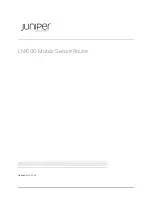
75
Step Command
Remarks
4.
Configure C-RP timeout timer.
c-rp holdtime
interval
Optional.
150 seconds by default.
Configuring a BSR
A BIDIR-PIM domain can have only one BSR, but must have at least one C-BSR. Any router can be
configured as a C-BSR. Elected from C-BSRs, the BSR collects and advertises RP information in the
BIDIR-PIM domain.
Configuring a C-BSR
C-BSRs must be configured on routers in the backbone network. When configuring a router as a C-BSR,
be sure to specify a PIM-SM-enabled interface on the router. The BSR election process is as follows:
•
Initially, every C-BSR assumes itself to be the BSR of the BIDIR-PIM domain, and uses its interface IP
address as the BSR address to send bootstrap messages.
•
When a C-BSR receives the bootstrap message of another C-BSR, it first compares its own priority
with the other C-BSR's priority carried in message. The C-BSR with a higher priority wins. If a tie
exists in the priority, the C-BSR with a higher IP address wins. The loser uses the winner's BSR
address to replace its own BSR address and no longer assumes itself to be the BSR, and the winner
retains its own BSR address and continues assuming itself to be the BSR.
Configuring a legal range of BSR addresses enables filtering of bootstrap messages based on the
address range, thereby preventing a maliciously configured host from masquerading as a BSR. The same
configuration must be made on all routers in the BIDIR-PIM domain. The following are typical BSR
spoofing cases and the corresponding preventive measures:
•
Some maliciously configured hosts can forge bootstrap messages to fool routers and change RP
mappings. Such attacks often occur on border routers. Because a BSR is inside the network whereas
hosts are outside the network, you can protect a BSR against attacks from external hosts by enabling
the border routers to perform neighbor checks and RPF checks on bootstrap messages and discard
unwanted messages.
•
When a router in the network is controlled by an attacker or when an illegal router is present in the
network, the attacker can configure this router as a C-BSR and make it win BSR election to control
the right of advertising RP information in the network. After being configured as a C-BSR, a router
automatically floods the network with bootstrap messages. Because a bootstrap message has a TTL
value of 1, the whole network will not be affected as long as the neighbor router discards these
bootstrap messages. Therefore, with a legal BSR address range configured on all routers in the
entire network, all these routers will discard bootstrap messages from out of the legal address
range.
The preventive measures can partially protect the security of BSRs in a network. If a legal BSR is controlled
by an attacker, the preceding problem will still occur.
Because the BSR and the other devices exchange a large amount of information in the BIDIR-PIM domain,
provide a relatively large bandwidth between the C-BSRs and the other devices.
For C-BSRs interconnected through a GRE tunnel, configure static multicast routes to make sure the next
hop to a C-BSR is a tunnel interface. For more information about static multicast routes, see "Configuring
multicast routing and forwarding."
To configure a C-BSR:
















































